The High Altitude Platform Market is estimated to be valued at USD 1.6 billion in 2025 and is projected to reach USD 2.5 billion by 2035, registering a compound annual growth rate (CAGR) of 5.0% over the forecast period. Early expansion is moderate, driven by pilot deployments and adoption in telecommunications, surveillance, and remote sensing applications. Initial growth is reinforced by technological validation, regulatory approvals, and niche use cases demonstrating operational viability.
Mid-period growth accelerates as commercial adoption increases, supported by improvements in platform endurance, payload capacity, and autonomous navigation systems. Deployment extends across both developed and emerging regions, with telecom operators, defense agencies, and scientific organizations integrating high altitude platforms into existing networks. Later years demonstrate stable and sustained growth, driven by replacement cycles, scaling of commercial applications, and broader integration into communication and observation infrastructure. Year-on-year growth exhibits a consistent upward slope, reflecting gradual market maturation and expanding application base.
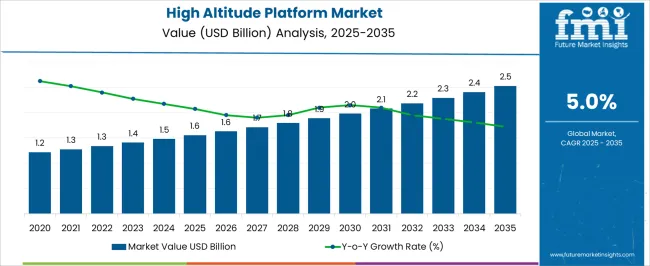
| Metric | Value |
|---|---|
| High Altitude Platform Market Estimated Value in (2025 E) | USD 1.6 billion |
| High Altitude Platform Market Forecast Value in (2035 F) | USD 2.5 billion |
| Forecast CAGR (2025 to 2035) | 5.0% |
The high altitude platform market is expanding steadily, driven by increasing demand for persistent aerial coverage and enhanced surveillance capabilities. Technological advances in unmanned aerial vehicles have enabled longer flight durations and improved payload capacities. Governments and defense agencies are focusing on border security, disaster management, and communication applications that benefit from high altitude monitoring.
Rising investments in defense modernization and homeland security initiatives have further stimulated market growth. Additionally, the scalability and cost-effectiveness of high altitude platforms compared to satellites have made them an attractive solution for real-time data acquisition.
The growing need for environmental monitoring and emergency response also supports market expansion. Segment growth is expected to be led by UAVs as the primary product, surveillance as the main application, and government and defense as the largest end-use sector.
The high altitude platform market is segmented by product, application, end-use, and geographic regions. By product, the high altitude platform market is divided into UAV, Airships, and Tethered Aerostat Systems. In terms of application, the high-altitude platform market is classified into Surveillance, Navigation & Remote Sensing, Communication, and EO/IR Systems. Based on end-use, the high altitude platform market is segmented into Government & Defense and Commercial. Regionally, the high altitude platform industry is classified into North America, Latin America, Western Europe, Eastern Europe, Balkan & Baltic Countries, Russia & Belarus, Central Asia, East Asia, South Asia & Pacific, and the Middle East & Africa.

The UAV segment is projected to hold 52.1% of the high altitude platform market revenue in 2025, retaining its position as the leading product type. This segment benefits from the versatility and adaptability of UAVs, which can be deployed quickly and operated remotely for various missions.
UAVs offer significant advantages in terms of lower operational costs and easier maintenance compared to manned platforms. The ability to carry diverse payloads such as sensors and cameras enhances their utility for surveillance and communication tasks.
Continuous improvements in UAV endurance and autonomy have also increased their effectiveness in high-altitude operations. These factors have combined to make UAVs the preferred choice in this market segment.
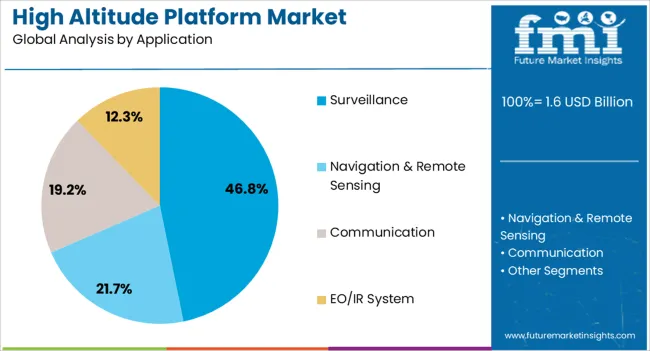
The surveillance application segment is expected to contribute 46.8% of the market revenue in 2025, leading the application categories. Demand has been driven by the need for persistent monitoring of critical infrastructure, borders, and sensitive regions.
High altitude platforms provide wide-area coverage and high-resolution imaging capabilities, enabling real-time threat detection and situational awareness. Enhanced data analytics and integration with command systems have improved response times and decision-making effectiveness.
Growing concerns over national security and the increasing frequency of natural disasters have further emphasized the importance of reliable surveillance solutions. As governments expand their security apparatus, surveillance applications are projected to maintain their dominant share.
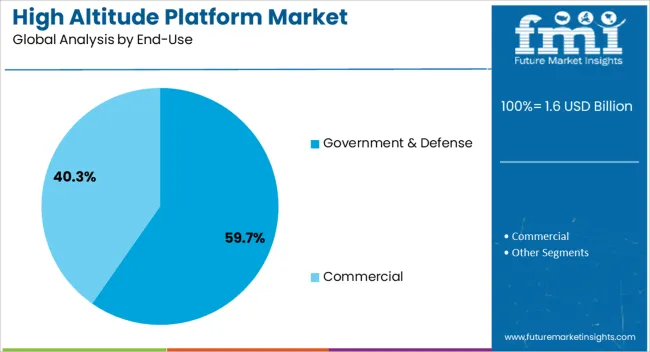
The government and defense segment is projected to account for 59.7% of the high altitude platform market revenue in 2025, underscoring its leading role in end-use. This segment benefits from significant budget allocations directed toward border security, intelligence gathering, and tactical communications.
The strategic importance of persistent aerial platforms in modern defense strategies has accelerated adoption rates. Additionally, government agencies utilize these platforms for disaster management, environmental monitoring, and emergency communications, further broadening their use cases.
Regulatory support and defense modernization programs are expected to sustain investments in this sector. The government and defense segment is poised to continue as the primary driver of market growth.
The high altitude platform market is shaped by defense applications, telecom expansion, environmental research, and advances in endurance and payload capacity. Together, these dynamics ensure steady adoption across both military and commercial domains.
High altitude platforms are becoming indispensable in modern defense strategies due to their ability to provide long-duration surveillance and reconnaissance. Unlike satellites, they offer faster deployment and lower operational costs, making them highly effective for monitoring sensitive borders and conflict zones. Defense agencies are increasingly adopting solar-powered airships and fixed-wing UAVs to support intelligence gathering, early warning systems, and real-time situational awareness. Their operational flexibility allows them to be stationed for weeks or even months at a time, ensuring continuous coverage over targeted areas. This growing reliance in defense applications significantly drives investments and expands the role of high altitude platforms in national security.
The demand for high-speed internet connectivity in underserved and remote regions is fueling adoption of high altitude platforms in telecommunications. Telecom operators are using these platforms as cost-effective alternatives to low earth orbit satellites, particularly in regions with limited ground-based infrastructure. Platforms such as stratospheric balloons and solar-powered UAVs are deployed to create high-capacity communication links, providing rural and hard-to-reach communities with affordable internet access. This dynamic is further supported by governments and private firms investing in initiatives to bridge the digital divide. The increasing reliance on broadband delivery through aerial platforms highlights their growing importance in the global telecom ecosystem.
High altitude platforms are increasingly employed for environmental monitoring, disaster response, and scientific research. They are capable of capturing high-resolution imagery, tracking climate change indicators, and observing atmospheric conditions for extended periods. Their lower cost compared to satellites makes them practical tools for meteorological studies, disaster management, and monitoring agricultural health. Agencies focused on climate resilience and ecological protection have adopted them for real-time assessment of natural disasters such as floods and forest fires. By providing consistent data over large regions, these platforms are reinforcing their role in research and environmental monitoring, expanding their application base beyond traditional defense and telecom.
Improvements in endurance, energy storage, and payload capacities are transforming the commercial viability of high altitude platforms. Lightweight composite structures, efficient solar panels, and advanced battery systems enable platforms to remain airborne for extended durations. At the same time, payload advancements in imaging sensors, communication systems, and radar technologies are enhancing their versatility across industries. These developments allow platforms to meet multiple demands such as surveillance, telecom backhaul, and scientific monitoring in a single deployment. The combination of longer endurance and higher payload capability is broadening their appeal among both commercial and defense customers, driving increased market penetration globally.
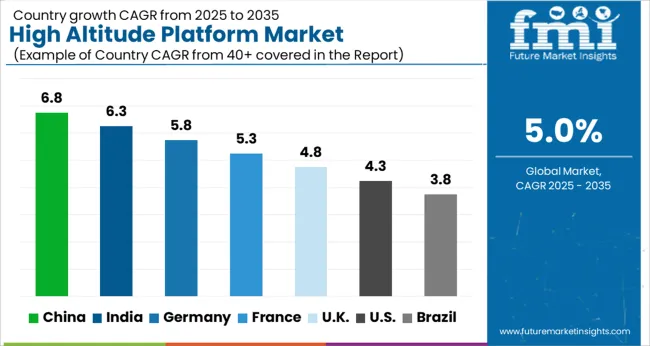
The high altitude platform market is projected to grow globally at a CAGR of 5.0% from 2025 to 2035, supported by expanding defense applications, telecom connectivity initiatives, and environmental monitoring projects. China leads with a CAGR of 6.8%, propelled by large-scale investments in surveillance, atmospheric research, and broadband delivery initiatives. India follows at 6.3%, driven by rising telecom requirements, defense modernization, and disaster monitoring projects. France posts 5.3%, with growth tied to atmospheric monitoring and European defense collaborations. The United Kingdom achieves 4.8%, influenced by defense-led trials and selective telecom deployments, while the United States grows at 4.3%, reflecting a mature market focused on upgrading defense and scientific research systems. This outlook highlights Asia’s lead in high altitude platform adoption, while Europe maintains strong momentum through research and defense integration, and the USA continues to modernize with steady but moderate demand.
The CAGR for the high altitude platform market in the United Kingdom was measured at 4.2% during 2020–2024 and improved to 4.8% for 2025–2035, pointing to stronger momentum in the next decade. The earlier phase was moderated by limited trials, regulatory delays, and constrained funding in large-scale telecom and defense programs. Growth strengthened as investments accelerated in defense-led surveillance initiatives and selective deployment for rural broadband coverage. The country’s need for persistent intelligence solutions and connectivity in remote areas enhanced procurement interest. Collaborative programs with European defense alliances also stimulated demand. This steady adoption trajectory underscores the role of HAPs in supporting both defense and communications priorities.
China’s CAGR for the high altitude platform market stood at 6.1% during 2020–2024 and accelerated to 6.8% in 2025–2035, reflecting robust growth trends. Initial expansion was shaped by early adoption in defense surveillance and weather monitoring, with pilot projects led by state-owned aerospace firms. The next stage has been marked by broader deployments in stratospheric connectivity, disaster response, and research programs. China’s growing need for real-time data collection, paired with investments in solar-powered and long-endurance systems, has driven continuous expansion. Its ability to deploy HAPs across strategic regions reinforces its global leadership in this technology.
India’s CAGR for the high altitude platform market was 5.6% during 2020–2024 and is projected to increase to 6.3% for 2025–2035, reflecting steady improvement. Early adoption was limited to pilot programs for disaster management and atmospheric data collection. However, the next wave is being driven by stronger investments in telecommunications connectivity, remote sensing, and defense modernization. The government’s digital initiatives and the need for low-cost alternatives to satellites in rural connectivity are accelerating demand. Partnerships between private telecom operators and defense agencies are also supporting wider adoption, positioning India as an emerging growth market for HAP solutions.

The CAGR for the high altitude platform market in France was 4.7% during 2020–2024 and improved to 5.3% during 2025–2035, showing measured but steady growth. Earlier progress was constrained by funding cycles and limited deployment beyond experimental projects. Growth in the later phase has been supported by France’s increasing focus on climate monitoring, European defense cooperation, and atmospheric research programs. Deployment of solar-powered platforms for environmental studies and cross-border surveillance projects has reinforced demand. France’s role in regional security frameworks and environmental monitoring has sustained the market’s upward trajectory.
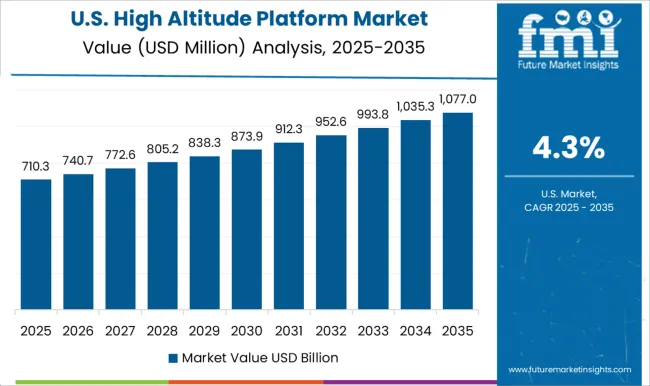
The CAGR for the high altitude platform market in the United States was 3.9% during 2020–2024 and is expected to rise modestly to 4.3% for 2025–2035, reflecting steady but moderate growth. The early period was influenced by limited defense budgets and competition from satellite-based systems, which slowed adoption. The later stage has been boosted by investments in persistent surveillance, homeland security, and scientific research programs. Upgrades in solar endurance technologies and high-resolution payloads have enhanced the USA adoption curve, though growth remains measured compared to Asia. The USA continues to prioritize targeted applications that align with national security and research priorities.
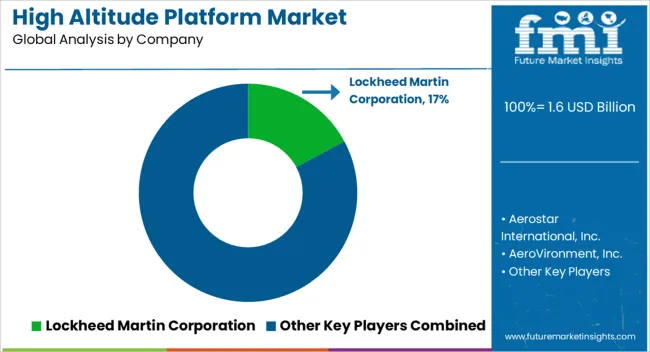
The high altitude platform market is highly competitive, with a mix of aerospace giants and specialized firms driving innovation in stratospheric systems for defense, telecom, and research. Lockheed Martin Corporation plays a leading role with its long-endurance ISR platforms designed for persistent surveillance. Aerostar International, Inc. focuses on stratospheric balloons and lighter-than-air systems for communications and intelligence missions. AeroVironment, Inc. is recognized for its solar-powered unmanned aerial systems with extended flight endurance.
Airbus SE drives development with its Zephyr platform, a solar-powered high-altitude UAV offering long-duration monitoring and connectivity. Avealto Ltd. specializes in telecom-focused high altitude airships for rural and underserved regions. Elektra Solar GmbH contributes with solar-electric aircraft tailored for environmental monitoring and scientific missions. ILC Dover L.P. is notable for its expertise in lighter-than-air structures and aerostats for military and civilian use.
Israel Aerospace Industries Ltd. integrates high altitude platforms with defense-grade payloads, while Lindstrand Technologies Ltd. focuses on tethered balloons and aerostats. Rafael Advanced Defense Systems Ltd. emphasizes HAPs for defense surveillance and communication. Raytheon Company enhances competitiveness by integrating advanced sensors and payloads into platforms for military clients. TCOM L.P. remains a leader in aerostat systems, widely deployed for defense and homeland security.
Thales Group contributes with multi-domain surveillance solutions leveraging HAP technologies, while Worldwide Aeros Corporation develops large airships for both defense and commercial communication needs. Key competitive strategies include improving endurance through solar and battery systems, enhancing payload versatility for telecom and ISR, and forming cross-industry partnerships. Differentiation is increasingly defined by the ability to integrate advanced sensors, ensure low-cost deployment, and scale solutions for both commercial and defense applications.
| Item | Value |
|---|---|
| Quantitative Units | USD 1.6 Billion |
| Product | UAV, Airships, and Tethered Aerostat Systems |
| Application | Surveillance, Navigation & Remote Sensing, Communication, and EO/IR System |
| End-Use | Government & Defense and Commercial |
| Regions Covered | North America, Europe, Asia-Pacific, Latin America, Middle East & Africa |
| Country Covered | United States, Canada, Germany, France, United Kingdom, China, Japan, India, Brazil, South Africa |
| Key Companies Profiled | Lockheed Martin Corporation, Aerostar International, Inc., AeroVironment, Inc., Airbus SE, Avealto Ltd., Elektra Solar GmbH, ILC Dover L.P., Israel Aerospace Industries Ltd., Lindstrand Technologies Ltd., Rafael Advanced Defense Systems Ltd., Raytheon Company, TCOM L.P., Thales Group, and Worldwide Aeros Corporation |
| Additional Attributes | Dollar sales, share, defense vs telecom adoption, regional growth hotspots, competitive strategies, payload technology trends, regulatory impacts, and long-term endurance innovations. |
The global high altitude platform market is estimated to be valued at USD 1.6 billion in 2025.
The market size for the high altitude platform market is projected to reach USD 2.5 billion by 2035.
The high altitude platform market is expected to grow at a 5.0% CAGR between 2025 and 2035.
The key product types in high altitude platform market are uav, airships and tethered aerostat systems.
In terms of application, surveillance segment to command 46.8% share in the high altitude platform market in 2025.






Full Research Suite comprises of:
Market outlook & trends analysis
Interviews & case studies
Strategic recommendations
Vendor profiles & capabilities analysis
5-year forecasts
8 regions and 60+ country-level data splits
Market segment data splits
12 months of continuous data updates
DELIVERED AS:
PDF EXCEL ONLINE
High Altitude Aeronautical Platform Stations Market Size and Share Forecast Outlook 2025 to 2035
High Temperature Heat Pump Dryers Market Size and Share Forecast Outlook 2025 to 2035
High Temperature Fiberglass Filter Media Market Size and Share Forecast Outlook 2025 to 2035
High Purity Tungsten Hexachloride Market Size and Share Forecast Outlook 2025 to 2035
High Purity Nano Aluminum Oxide Powder Market Size and Share Forecast Outlook 2025 to 2035
High Mast Lighting Market Forecast and Outlook 2025 to 2035
High-Protein Pudding Market Forecast and Outlook 2025 to 2035
High Voltage Ceramic Zinc Oxide Surge Arrester Market Size and Share Forecast Outlook 2025 to 2035
High-Power Microwave Source Market Size and Share Forecast Outlook 2025 to 2035
High Performance Epoxy Coating Market Size and Share Forecast Outlook 2025 to 2035
High Molecular Ammonium Polyphosphate Market Size and Share Forecast Outlook 2025 to 2035
High Performance Fluoropolymer Market Size and Share Forecast Outlook 2025 to 2035
High Throughput Screening Market Size and Share Forecast Outlook 2025 to 2035
High Barrier Packaging Films for Pharmaceuticals Market Size and Share Forecast Outlook 2025 to 2035
High Barrier Packaging Films Market Size and Share Forecast Outlook 2025 to 2035
High Purity Carbonyl Iron Powder (CIP) Market Size and Share Forecast Outlook 2025 to 2035
High Voltage PTC Heater Market Size and Share Forecast Outlook 2025 to 2035
High-Performance Fiber Market Size and Share Forecast Outlook 2025 to 2035
High Temperature Grease Market Size and Share Forecast Outlook 2025 to 2035
High Frequency Chest-Wall Oscillation Devices Market Size and Share Forecast Outlook 2025 to 2035

Thank you!
You will receive an email from our Business Development Manager. Please be sure to check your SPAM/JUNK folder too.
Chat With
MaRIA